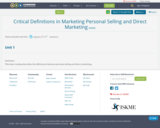
This short reading describes the differences between personal selling and direct marketing.
- Subject:
- Business and Communication
- Marketing
- Material Type:
- Reading
- Date Added:
- 06/26/2019

This short reading describes the differences between personal selling and direct marketing.
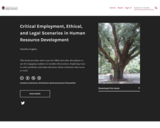
Short Description:
This book provides mini-cases for HRD and other disciplines to use for engaging students in incident discussions. Exploring ways to solve problems and make decisions about situations that occur at work.
Long Description:
This book is intended to be used as a supplement to courses across various fields of study but has direct correlations with human resource development and workforce development. Instructors in any field of study where students examine the work environment and the treatment of employees will find useful scenarios that can be used to facilitate discussions. The topics in this book and supplemental readings can enrich the conversations around enhancing workplace environments and better worker engagement. Without supportive workers, organizations cannot achieve all goals to the extent desired. Workers may exert the effort required to keep their jobs, but they may not exceed performance requirements because they are experiencing scenarios similar to those in this book and their needs are not being met appropriately.
Leaders and workplace trainers may find this supplement useful when introducing subjects that are perceived to be controversial in the workplace. They can allow employees to discuss these scenarios and provide possible solutions to similar scenarios that are encountered at work. Providing a safe environment to discuss intentional and unintentional situations that arise may improve the work climate and lead to unimaginable solutions. Strengthening communication between workers and leaders can improve team performance and ultimately, organizational success.
Word Count: 12056
(Note: This resource's metadata has been created automatically by reformatting and/or combining the information that the author initially provided as part of a bulk import process.)

A cross-cultural perspective
Short Description:
This collection of student essays is the result of a collaborative online international learning (COIL) class by our students from the University of Guelph in Canada, the University of Navarra in Pamplona, Spain, and the IPMI International Business School in Jakarta, Indonesia. Students were formed into cross-cultural groups and interacted on a weekly basis via an online video communication platform to analyze business innovations in the context of the UN Sustainable Development Goals (SDGs). The instructors provided guidance throughout the experiential activity and curated the content so that all 17 SDGs were discussed in this book.
Long Description:
This collection of student essays is the result of a collaborative online international learning (COIL) class by our students from the University of Guelph in Canada, the University of Navarra in Pamplona, Spain, and the IPMI International Business School in Jakarta, Indonesia. Students were formed into cross-cultural groups and interacted on a weekly basis via an online video communication platform to analyze business innovations in the context of the UN Sustainable Development Goals (SDGs). The instructors provided guidance throughout the experiential activity and curated the content so that all 17 SDGs were discussed in this book.
Word Count: 69206
ISBN: 978-1-7782569-0-5
(Note: This resource's metadata has been created automatically by reformatting and/or combining the information that the author initially provided as part of a bulk import process.)

This first chapter explains what it means to be logical—to reason logically. It demonstrates the usefulness of logical reasoning as a means to making more effective decisions about your own life—decisions about what to believe and decisions about what to do. The chapter begins a systematic program of study of all the major topics regarding logical reasoning. Along the way, the book focuses on developing the following five skills: (1) writing logically, (2) detecting inconsistency and lack of clarity in a group of sentences, (3) spotting issues and arguments, (4) detecting and avoiding fallacies (reasoning errors), and (5) generating and improving arguments and explanations. These skills will be taught here independent of subject matter.
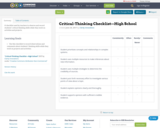
A checklist used by teachers to observe and record students’ critical-thinking skills while they work on activities and projects.
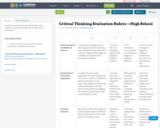
A rubric in student language used by high school students to assess their evaluation of the quality of information.
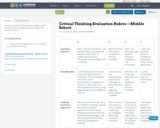
A rubric in student language used by middle school students to self-assess their ability to evaluate the quality of sources.

This video covers the basics of refutation in competitive debate. The advice here is aimed at IPDA, Parli, and NFA-LD style debate, but may also be useful for other formats.
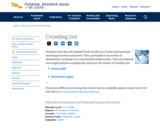
Students learn that the loanable funds market is a virtual clearing house matching borrowers and savers. They participate in an activity to demonstrate crowding out in the loanable funds market. They use demand and supply analysis to graphically represent the results of crowding out.
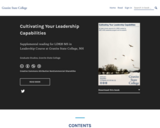
Supplemental reading for LD820 MS in Leadership Course at Granite State College, NH
Word Count: 50854
(Note: This resource's metadata has been created automatically by reformatting and/or combining the information that the author initially provided as part of a bulk import process.)

This video examines how culture affects emotions.

This class addresses important, current debates in media with in-depth discussion of popular perceptions and policy implications. Students will engage in the critical study of the economic, political, social, and cultural significance of media, and learn to identify, analyze, and understand the complex relations among media texts, policies, institutions, industries, and infrastructures. This class offers the opportunity to discuss, in stimulating and challenging ways, topics such as ideology, propaganda, net neutrality, big data, digital hacktivism, digital rebellion, media violence, gamification, collective intelligence, participatory culture, intellectual property, artificial intelligence, etc., from historical, transcultural, and multiple methodological perspectives.
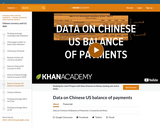
Data on Chinese / U.S. balance of payments. [Economics playlist: Lesson 17 of 20]

Problem based accounting learning activity for notes and interest payable, sales tax payable, and payroll.

Short Description:
This book is written for the typical computer user: someone who uses computers for day-to-day activities (browsing the web, sending/receiving email, etc.) and is interested in delving a bit deeper into some of the current technology concepts and terminology.
Long Description:
This book is written for the typical computer user: someone who uses computers for day-to-day activities (browsing the web, sending/receiving email, etc.) and is interested in delving a bit deeper into some of the current technology concepts and terminology.
Word Count: 24004
ISBN: 978-1-77420-191-6
(Note: This resource's metadata has been created automatically by reformatting and/or combining the information that the author initially provided as part of a bulk import process.)
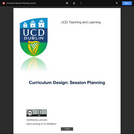
This workbook provides a 'how to' guide to developing effective curriculum session design. It offers activities and planning tools to enable the end user to review, design and complete their own teaching plans.

Get Fast Packaging is a One-stop shop for custom packaging and wholesale custom printed boxes that fit to your budget. Free Custom design. Available in all Sizes, Colors & Shapes. Get Free Quote! Free shipping worldwide!
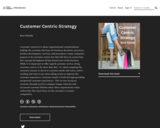
Short Description:
Customer centricity is about organizational transformation making the customer the focus for business decisions, processes, product development, services, and procedures. Some companies purport to be customer centric but they fall short in connecting this concept throughout all functional areas of the business. While it is important to offer superb customer service, being customer centric is far more than that. It's about mapping the customer journey to discover customer needs and wants, what's working and what is not, then taking action to improve the customer experience. Customer loyalty is built through providing exceptional customer experiences. This in turn increases revenues through positive company image, referrals, and increased customer lifetime value. Most organizations today realize that they must focus on the customer to remain competitive.
Word Count: 44793
(Note: This resource's metadata has been created automatically by reformatting and/or combining the information that the author initially provided as part of a bulk import process.)
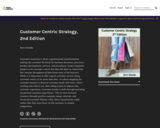
Customer centricity is about organizational transformation making the customer the focus for business decisions, processes, product development, services, and procedures. Some companies purport to be customer centric but they fall short in connecting this concept throughout all functional areas of the business. While it is important to offer superb customer service, being customer centric is far more than that. It's about mapping the customer journey to discover customer needs and wants, what's working and what is not, then taking action to improve the customer experience. Customer loyalty is built through providing exceptional customer experiences. This in turn increases revenues through positive company image, referrals, and increased customer lifetime value. Most organizations today realize that they must focus on the customer to remain competitive.
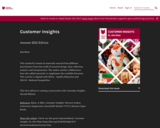
Autumn 2022 Edition
Short Description:
This textbook is based on materials sourced from different practitioners from the world of research design, data collection, analysis, and interpretation. The author and her collaborators have also added materials to supplement the available literature. This activity is aligned with SDG4 – Quality Education and SDG10 - Reduced Inequalities. NewParaThis first edition is running concurrently with Customer Insights. Second Edition.
Long Description:
Increasingly, the concept of marketing research is being replaced with the term ‘customer or consumer insights’. As decision-makers are bombarded with data, it is important to have an Insights Team or Department which can sift through it all and identify those nuggets of information that can meaningfully explain human behaviour. Such insights must translate into an informed business strategy for success. This book has been curated to ensure that the practice of data collection, analysis, and interpretation is presented from an industry perspective. This first edition is running concurrently with Customer Insights. Second Edition https://oercollective.caul.edu.au/customer-insights/
Word Count: 41271
(Note: This resource's metadata has been created automatically by reformatting and/or combining the information that the author initially provided as part of a bulk import process.)